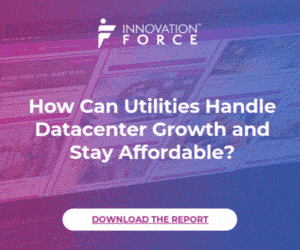Imagine the chaos that follows a major storm. It doesn't just knock out power lines – it floods streets, damages buildings and disrupts entire communities. Both utilities and city departments scramble to respond, often with little coordination. Not long ago, it wasn’t uncommon for a city’s water department to dig up a street only to find that the electric utility had done the same thing just weeks earlier, with neither party aware of the other’s plans.
Those days are quickly becoming outdated. Today, many urban centers are experiencing a significant technological transformation as innovative smart city platforms bridge the traditional divide between utility providers and city departments. Unified data ecosystems are enabling real-time collaboration between utilities and municipalities, breaking down silos and forging new models of partnership. This ensures better resource management, more sustainable operations and significantly better public services to residents.
Shared challenges, common customers
At the foundation of effective utility-municipality collaboration lies a simple but powerful insight: these entities serve the same constituents and face many of the same challenges. Residents and businesses within a city are simultaneously customers of both the utility and the municipality. This shared customer base 01creates a natural alignment of interests that, when properly leveraged, can transform traditionally separate operations into coordinated efforts.
Both utilities and municipalities face shared challenges around environmental impacts that frequently damage utility infrastructure while simultaneously disrupting city operations. Yet, they still need to deliver reliable services to their communities. Utilities are racing to harden their infrastructure against increasingly severe weather, while city governments are trying to protect residents from flooding, heat waves and other climate hazards.
By adopting a unified approach to these challenges, utilities and municipalities can create win-win scenarios that benefit all stakeholders. That's exactly what's happening in forward-thinking cities across the country. By sharing data and coordinating their efforts, utilities and municipalities are creating partnerships that make our cities more resilient, sustainable and efficient.
When they work together – sharing resources, data and planning – communities recover faster.
At the same time, sustainability goals are getting more ambitious. Cities are setting bold carbon reduction targets while utilities are transitioning to renewable energy. By coordinating their efforts through shared data platforms, they can both track progress more effectively and uncover new opportunities for collaboration.
The overlapping responsibilities and challenges faced by utilities and municipalities include:
- Climate resilience and adaptation – Both entities are on the front lines of climate change impacts:
- Utilities must harden infrastructure against extreme weather while maintaining service reliability
- Municipalities must protect residents and businesses from flooding, heat waves and other climate hazards
- Both must coordinate emergency response during disasters and service restoration afterwards
- Shared data platforms enable rapid information distribution to facilitate coordinated planning and response across organizational boundaries
- Utilities must harden infrastructure against extreme weather while maintaining service reliability
- Sustainability and environmental goals – Cities and utilities both face increasing pressure to reduce greenhouse gas emissions:
- Municipalities establish climate action plans with carbon reduction targets
- Utilities transition toward renewable energy and implement efficiency programs
- Both must monitor and report on environmental metrics to various stakeholders
- Collaborative platforms enable integrated tracking of carbon footprints and other environmental indicators
- Municipalities establish climate action plans with carbon reduction targets
- Infrastructure modernization – Aging infrastructure presents challenges for both entities:
- Utilities must upgrade electrical grids, water systems and gas networks while maintaining service
- Municipalities face similar challenges with roads, bridges, buildings and other public assets
- Both must coordinate construction activities to minimize disruption and maximize efficiency
- Shared planning tools and data exchange reduce conflicts and enable coordinated capital improvements
- Utilities must upgrade electrical grids, water systems and gas networks while maintaining service
- Financial constraints – Both entities operate under significant budget limitations:
- Utilities must balance infrastructure investment with affordable rates for customers and, in some cases, returns for their shareholders
- Municipalities must provide essential services while maintaining reasonable tax burdens
- Both face increasing costs for regulatory compliance and security requirements
- Collaborative approaches can reduce duplicative investments and create operational efficiencies
- Utilities must balance infrastructure investment with affordable rates for customers and, in some cases, returns for their shareholders
- Public expectations and service quality – Citizens expect seamless, responsive service:
- Utilities must maintain reliable services with minimal interruptions
- Municipalities must deliver efficient public services across diverse domains
- Both must communicate effectively with the same constituent base
- Unified platforms can improve service coordination and provide consistent information to residents, visitors and businesses
- Utilities must maintain reliable services with minimal interruptions
Data: The great connector
Central to this collaborative transformation is the emergence of unified data platforms that integrate information from diverse sources across both utility and municipal domains. These platforms bring together information from countless smart devices – everything from smart meters and streetlights to traffic sensors and environmental monitors. The real magic happens when this data becomes accessible across organizational boundaries while still maintaining appropriate security controls.
Think of it as creating a digital conversation between systems that never talked to each other before. When a severe storm is approaching, emergency managers can see real-time data from the utility about vulnerable infrastructure, while utility repair crews get immediate updates about road closures and flooding from city systems.
What makes these platforms so powerful is their ability to spot connections that humans might miss. Through sophisticated "if this, then that" logic, they can identify patterns across diverse data sets and trigger appropriate responses automatically – whether that's dimming streetlights to save energy during peak demand periods or rerouting traffic away from utility repair work.
The architectural elements that make these unified platforms so powerful include:
- Multi-layer data integration – These platforms collect, normalize and integrate data across three key dimensions:
- Vertical integration across the technology stack connecting physical devices in the field to applications
- Horizontal integration across different departments, agencies and utilities
- Temporal integration combining historical data with real-time inputs to enable predictive capabilities
- Vertical integration across the technology stack connecting physical devices in the field to applications
- Federated security models – Advanced security architectures maintain appropriate access controls while enabling collaboration, including:
- Data-level security defining which specific data elements can be accessed by which users
- Role-based access control mapping organizational responsibilities to data access privileges
- Contextual security adapting access rights based on circumstances
- Audit trails tracking all data access and system interactions for compliance and security monitoring
- Data-level security defining which specific data elements can be accessed by which users
- Scalable data processing – These platforms implement sophisticated data handling capabilities:
- Edge processing that filters and pre-processes data near its source to reduce bandwidth requirements
- Stream processing for real-time analysis of data flows from thousands or millions of endpoints
- Batch processing for deeper analytical workloads across historical datasets
- Distributed storage architectures that balance performance, cost and data retention requirements
- Edge processing that filters and pre-processes data near its source to reduce bandwidth requirements
Real-world success: Chicago smart streetlights
Chicago provides a perfect example of what's possible. The city deployed roughly 280,000 LED streetlights equipped with smart controllers that communicate over a dedicated network. For decades, streetlight billing was based on rough estimates such as how many lights were installed, multiplied by assumed hours of operation and energy rates. With smart controllers, the city now pays for exactly what it uses, including when lights are dimmed to save energy.
The results speak for themselves: Chicago projected $100 million in savings over ten years – about $10 million annually – from reduced energy costs and more efficient maintenance. When a light fails, the system immediately reports the exact location and problem, so repair crews arrive prepared with the right equipment. But the benefits go far beyond just saving money. City operators can adjust lighting levels in specific areas based on safety concerns or citizen feedback about light pollution. And the network infrastructure supporting these smart lights creates a foundation for other applications.
The Chicago implementation illustrates several key aspects of successful utility-city collaboration:
- Data-driven operations – The smart controllers collect granular data on each streetlight's performance, enabling each organization to optimize its operations based on shared, accurate information rather than estimates or assumptions.
- Dynamic control capabilities – Beyond simple on/off functionality, the system enables precise control of lighting levels. City operators can adjust brightness levels in response to citizen concerns about light pollution or to address specific safety issues in targeted areas.
- Maintenance transformation – The deployment has fundamentally changed how streetlight maintenance operates, transitioning from reactive to proactive maintenance with automated alerts about specific issues at specific locations, including diagnostic information about the nature of the problem.
- Infrastructure for additional applications – While streetlighting served as the anchor application, the network infrastructure deployed to support the lighting controllers creates a foundation for additional smart city applications.
- Financial model innovation – The project demonstrates how technology can enable new financial arrangements between utilities and cities through more accurate billing models that benefit both parties.
San Antonio's united utilities
In San Antonio, TX, a different kind of collaboration emerged when CPS Energy (the local utility) installed smart electric and gas meters throughout the metropolitan area. Rather than building separate infrastructure, the San Antonio Water System (SAWS) integrated its water meters into the same system.
This partnership saved substantial money by sharing network costs across multiple utilities. Though both organizations operate under the municipal umbrella, they function as separate entities with distinct priorities while servicing a common customer base. The unified platform gives each utility access only to its relevant data while sharing infrastructure costs.
This creates economies of scale that benefit everyone, from the utilities themselves to the residents they serve. This implementation highlights several important dimensions of cross-utility collaboration:
- Shared infrastructure economics – By leveraging the existing network infrastructure established for electric and gas metering, the water utility avoided substantial capital expenditure, creating economies of scale that benefit all parties.
- Multi-tenant security model – The platform implements sophisticated role-based access controls that maintain appropriate separation between different utilities' data while enabling the infrastructure sharing that makes the collaboration economically attractive.
- Phased deployment approach – The San Antonio example demonstrates how collaborative platforms can evolve over time, with water metering added after the initial deployment of electric and gas metering.
- Cross-utility innovation opportunities – By bringing multiple utility data streams into a common platform, new opportunities emerge for cross-utility analytics and service improvements, such as correlating water usage patterns with electricity consumption to identify potential leaks.
Making it work: Practical implementation strategies
So how do cities and utilities build these collaborative systems? It typically starts with an "anchor application" – a specific use case that drives the initial investment. In recent years, this has been streetlighting as they were converted to LED technology. This is especially true outside the United States where cities frequently own and operate lighting infrastructure.
The most successful implementations follow several key principles:
- Start with a high-value use case: It’s sensible to start with something concrete and valuable, with applications that deliver clear, measurable benefits to build momentum and demonstrate return on investment. Smart streetlighting often works well because it delivers quantifiable energy savings while creating visible improvements in public spaces.
- Design for scalability and scope: It’s good practice to choose network technologies with appropriate bandwidth, coverage and security capabilities and select software platforms with open APIs and standards-based interfaces.
- Engage stakeholders early and often: Establishing formal governance mechanisms that bring together stakeholders from multiple departments and organizations requires both leadership commitment and operational coordination. Creating a roadmap for growth and developing multi-year plans that outline how the platform will evolve from initial applications to broader capabilities is a sound strategy. This should align with capital planning cycles and establish clear metrics for measuring success at each phase.
- Prioritize people alongside technology: Investing in workforce development to ensure staff have the skills to use these systems effectively enhances employee value and can increase job satisfaction. This includes technical training on specific tools and broader education on data-driven decision-making.
Keeping it open
One of the biggest pitfalls in smart city implementation is the creation of closed, proprietary systems that can't talk to each other. To avoid this, forward-thinking cities and utilities embrace an open framework approach that supports standardized connectivity and data models. This means implementing well-defined interfaces between different system layers, using established standards rather than proprietary protocols wherever possible and creating common data models. For instance, core concepts like "streetlight" or "air quality measurement" should have consistent definitions across platforms and departments.
Equally important is embedding security from the ground up. Security must be built into every layer of the architecture rather than bolted on as an afterthought to protect sensitive data and ensure system integrity. As these platforms evolve from basic data collection to more sophisticated analytics, they also require scalable tools for analytics and decision-making. That includes extensible capabilities for data processing, user-friendly visualization tools and mechanisms to translate raw information into actionable insights.
The benefits are real
The collaborative platforms emerging in smart cities deliver multiple benefits:
- Unified ecosystems: By integrating data from diverse IoT devices into a single platform governed by predefined access rules, these systems eliminate the need for multiple parallel networks and create economies of scale.
- Cross-domain intelligence: When information is correlated across departments and domains, patterns emerge that siloed systems can’t detect. This enables more effective planning and coordination between utility recovery teams and city emergency services.
- Responsive public services: They enable more responsive public services with near real-time adjustments based on current conditions rather than fixed schedules. This creates more efficient resource utilization while improving service delivery to residents.
- Sustainable insights: With detailed visibility into how resources are consumed across systems, cities can launch more precise and impactful conservation and environmental programs, tracking progress and adjusting strategies in real time.
- Operational efficiency: Beyond simple energy efficiency, these platforms unlock new efficiencies through predictive maintenance capabilities, resource optimization and automation across multiple city departments and utility operations.
Looking ahead
As these collaborative platforms mature, several exciting possibilities are emerging. Electrification and distributed energy integration will become increasingly important as cities and utilities work to decarbonize. Collaborative platforms will play a crucial role in managing the transition to electric vehicles and integrating distributed energy resources, optimizing charging infrastructure based on grid capacity and traffic patterns.
Advanced analytics and machine learning applications will flourish with the vast datasets generated by unified platforms. Predictive models will help both utilities and municipalities optimize operations in ways we're just beginning to imagine.
Citizen engagement and transparency will transform how people interact with utilities and municipal services. While respecting privacy concerns, these platforms can provide personalized dashboards and real-time information about service disruptions or planned maintenance. In a world where everyone expects instant, real-time information seamlessly delivered through smartphones and apps like Amazon and Uber, it is even more important to have a unified system that can present the latest data as quickly as possible.
Regional coordination and resilience planning will extend beyond city boundaries, with collaborative models connecting multiple municipalities and utilities. This creates even greater efficiencies and resilience for disaster response and infrastructure planning.
The big picture
As cities face mounting challenges from climate change, resource constraints and growing expectations, these collaborative smart city platforms aren't just nice to have – they're becoming essential infrastructure.
The shift from siloed operations to integrated, data-driven collaboration represents the most significant transformation in urban management of the digital era. By bringing utilities and municipalities together around shared data and common goals, smart city technology is helping create more livable, sustainable and resilient communities for all of us.
The walls between traditionally separate operations are coming down, and in their place, we're building bridges – digital connections that help our cities and utilities work together more effectively than ever before. The future of our cities depends on it.

Dan Evans is senior director of product management at Itron, where he defines the product roadmap for the Smart Cities and Smart Lighting business unit. Evans joined Itron through their recent acquisition of Silver Spring Networks. Before joining Silver Spring Networks in 2007, Evans had more than 30 years of experience in the networking space at SkyPilot Networks, Excite@Home and NASA. He has a Bachelor of Science degree in computer science from San Jose State University in California.







